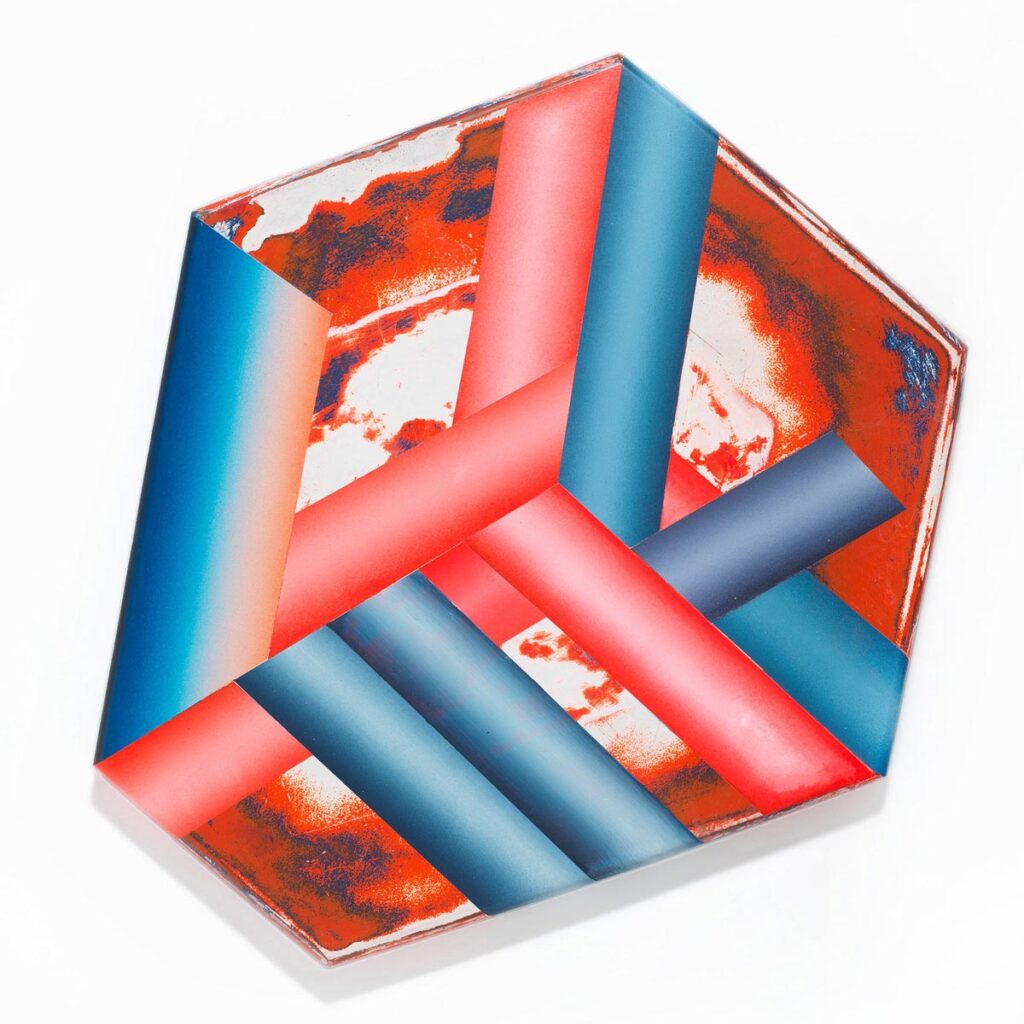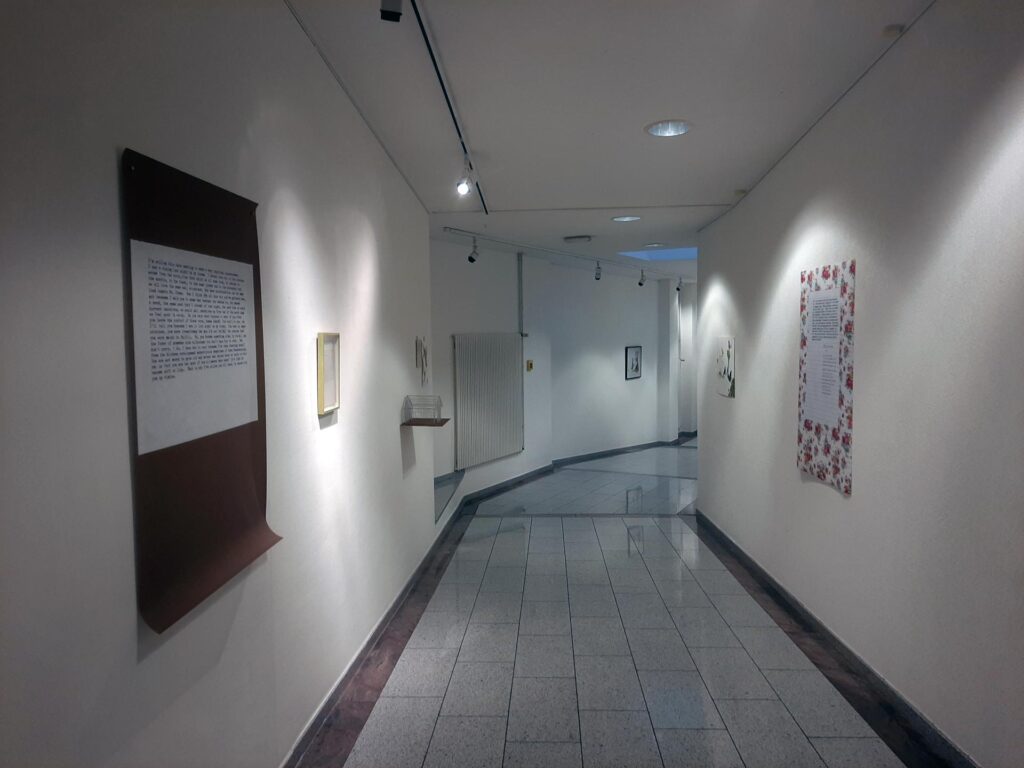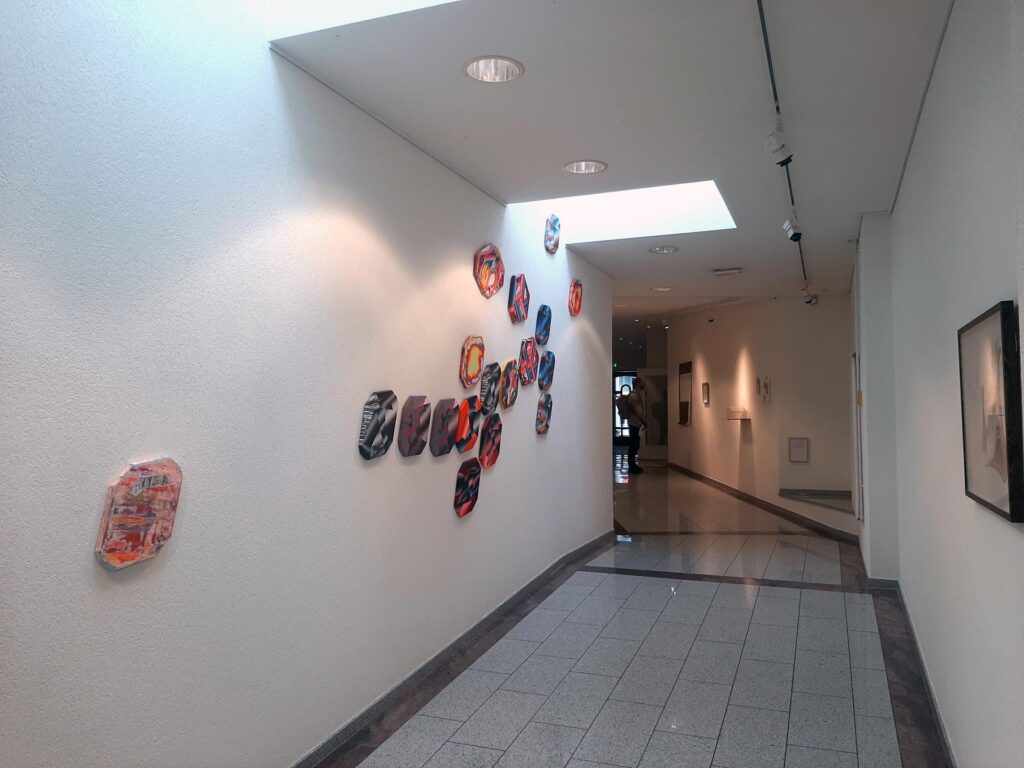Passages en Passant #2:
Barbara Helmer & Rachel Carey
September 3 – Oktober 1, 2021
Het interview
(english below)
Eva Visser
Dit interview poogt inhoudelijk aan te sluiten bij de opzet van de curatoren van Passages en passant: het faciliteren van een ontmoeting tussen het werk van twee kunstenaars in de bijzondere tentoonstellingsruimte in de gang van het Goethe-Institut. Mijn vragen betroffen daarom vooral de interactie tussen de kunstenaars, hun interactie met de ruimte – en de plaats van elkaars werk daarin – en de interactie van de bezoekers met de kunstwerken. Het interview is vormgegeven als een tweegesprek waarin de kunstenaars elkaar aanvullen.
Barbara: Ik kende Rachel alleen van gezicht. Toen we voor deze expositie gevraagd waren heb ik geprobeerd haar online op te zoeken. Dat was niet gemakkelijk – ze heeft geen social media accounts. Toen ik haar werk uiteindelijk zag vond ik het erg goed.
Rachel: Mijn gebrek aan sociale media is opzettelijk; mijn website is rudimentair en heeft maar één afbeelding. Bovendien zijn veel Rachel Carey’s die kunstenaars zijn.
R: Ik kende Barbara’s werk wel, door een grappig toeval. In het Paasweekend waren mijn vriend en ik aan het wandelen met vrienden en toen zei een van hen, Carolin [Lange], dat ik eens naar het werk van Barbara Helmer moest kijken omdat ze dacht dat ik dat interessant zou vinden. Dus toen heb ik haar werk opgezocht, op de websites van de stichting B.a.d. en het CBK. Ik verwachtte dat Barbara’s werk op de een of andere manier vergelijkbaar zou zijn met het mijne, maar het was heel anders, heel grafisch. Maar ik vond het inderdaad goed; ik houd van de combinatie van zorgvuldigheid en punkachtige vrijheid in haar werk. En ik houd van de beweging die haar werk suggereert – er zit richting in. Dus toen Kathrin [Wolkowicz] belde en voorstelde dat Barbara en ik samen een show zouden doen, dacht ik: ‘Ik ken haar werk, dit is spannend!’
R: Ik kende de ruimte niet, maar het is een speciale ruime met het knakje en het bovenlicht.
B: Mijn moeder komt uit Duitsland en ik heb een paar jaar geleden lessen gevolgd – ik heb hier C1 en C2 examens Duits gedaan. Dus ik kende de ruimte; ik vond het een fantastische expositieruimte. Ik heb hier eerder meegedaan aan een groepstentoonstelling, van Appendix. Via hen ben ik vorig jaar in Dresden terechtgekomen voor een residentie – ook geweldig – over dat project komt ook nog een expositie hier. Een tijdje geleden kwam Marco [Douma] langs, die mijn werk al langer volgt omdat hij ook bij B.a.d. zit, en hij zei: ‘nu wordt het goed’. En nu vroeg hij met dus de schilderwerken, die ik gemaakt heb tussen 2018 en 2020, hier te exposeren; fantastisch!
R: Kathrin vroeg specifiek naar mijn tekstwerken. Ik was terughoudend omdat ze verschillende stemmen hebben maar er allemaal hetzelfde uitzien. Bovendien weet ik dat mensen over het algemeen nogal lui zijn en geen zin hebben om teksten te lezen. Kathrin stelde voor om de werken groter te maken en dat heb ik dus gedaan; nu lijken ze op posters. Ik vind het formaat erg mooi – op posterformaat lijken de teksten op propaganda. De posters zien er allemaal grotendeels hetzelfde uit, ze zijn allemaal op de typemachine geschreven – maar ze hebben heel verschillende stemmen en om dat te laten zien heb ik er subtiele hints van persoonlijkheid aan toegevoegd. Voor de aardappel heb ik bijvoorbeeld een aardappelschil gescand voor de achtergrond, voor een andere een oud keukenbehang. Door deze expositie heb ik nu een posterdrang.
B: Onze eerste ontmoeting was hier, beneden, met z’n vieren. Toen ging er een vakantie overheen en daarna hebben we het gewoon gedaan.
R: Barbara ging er gewoon in. Ze was heel snel klaar. Ze is een vrouw met een plan. Dat gaf me eigenlijk rust, want we hoefden niet de gebruikelijke beleefde onderhandelingen te doen – waarbij uiteindelijk niemand echt krijgt wat hij wilde. Nu kon ik gewoon om haar beslissingen heen werken. Ik ben een besluiteloos persoon, dus soms is het fijn als mensen beslissingen voor me nemen: één gedaan, nog twintig te gaan. Ik was niet overweldigd door Barbara’s werk, want ik was bezig met het aantal van mijn werken te verminderen en te beslissen welke waar zouden komen. Toch was ik erg traag in het beslissen wat waar moest komen, hoe ik de werken wilde installeren.
B: Het was lang geleden dat je je werk had laten zien. Ik doe het vaker, dus het is makkelijker voor me geworden. Ik had net een beurs gedaan, This Art Fair, dus al mijn werk stond ingepakt en ik kon het gelijk hierheen brengen – hier heb ik dezelfde twintig werken getoond als daar. Op die beurs had ik er eerst, op het advies van een coach, weinig opgehangen en veel ruimte open gelaten, maar dat beviel mij toch niet, dat museale hangen – dat kan heel saai worden met dit werk. Dus na twee dagen had ik het alsnog volgehangen en toen vond ik het wel leuk. En het werk mag ook verkocht worden; door deze manier van ophangen kunnen mensen zien dat sommige werken heel mooi bij elkaar passen en denken ‘ik neem er twee, of drie.’ Hier komen er ook nog wat mensen kijken die interesse hebben.
B: Voor de installatie hier had ik toch al iets in mijn hoofd merkte ik – ik wilde graag de muur die omhoog komt. Je kan hier tot bijna vijf meter hoog, naar het daglicht toe. Eerst heb ik het op de vloer neergelegd om ongeveer te kijken wat waar zou moeten komen. Je kan het werk versterken door het goed te hangen. Contrast van werken vind ik mooi, maar ook toon naast toon. Soms zie je dat het elkaar afzwakt, dan moeten die niet naast elkaar. Maar het is allemaal heel intuïtief. Toen ben ik gaan hangen en heb ik het nog een beetje bijgesteld: wat werken wisselen en een beetje hoger of lager. Ik deed de meeste in één dag; misschien drie of vijf de volgende dag.
R: Het heeft me meer tijd gekost. De posters waren dus nieuw en een ontdekking voor mij. Ze veranderden ook de andere werken omdat de werken in relatie tot elkaar staan – dat was best ingewikkeld. Het opbouwproces was heel intuïtief, organisch. Ik werkte rond haar werk op een manier die het werk van ons beiden aanvulde.
Ik denk dat mijn werk en dat van Barbara allebei nogal geladen zijn, op een goede manier. Dat maakte het belangrijk om er ademruimte tussen te laten. Anders zouden onze werken elkaars lading opheffen. Mijn werk is nogal aards en haar werk brandt. Haar werk had vrijheid nodig. Barbara’s werk kon daar, op die muur, bewegen; haar stukken willen bewegen als een zwerm vogels. Dat vormde een heel mooi contrast met mijn meer lineaire werk. Ik heb echt technocratisch werk, dat niet wil bewegen. Intuïtief deden we ons eigen ding en dat pakte heel mooi uit. We observeerden elkaars werk en daardoor luisterden we naar elkaar. Ik denk dat er een hele mooie flow is.
R: Deze expositie houdt het midden tussen een solo en een groepstentoonstelling; het zijn een soort van twee solo’s. Maar mensen zoeken altijd naar verbanden, overeenkomsten en contrasten als je twee dingen samenbrengt; ik vond het ook leuk dat ik verbanden zag. Er is geen thema – maar mensen gaan op zoek naar een thema.
Eva Visser is een Rotterdamse historicus die onderwijs geeft, onderzoek doet naar technologisch-utopisch denken en graag over kunst(enaars) schrijft. Ze heeft bijgedragen aan het blad Puntkomma en online platform In Proximity to the Arts.


CERN van Barbara Helmer
In the beginning chaos van Rachel Carey


Overzicht tentoonstelling met werk van Rachel
Links werk van Barbara en rechts van Rachel
The interview
Eva Visser
This interview ties in with the intention of the curators of Passages en Passant: to facilitate a meeting between the work of two artists in the corridor of the Goethe-Institut, which is used as a special exhibition space. The interview focuses on the interaction between the artists, their interaction with the space – and the place of each other’s work in it – and the interaction of the visitors with the work. The interview is designed as a two-way conversation in which the artists complement each other.
Barbara: I only knew Rachel by sight. When we were invited to exhibit, I tried to look her up online. That was not easy – she has no social media accounts. When I finally saw her work I was surprised by how good I thought it was.
Rachel: My lack of social media presence is intentional and my website is rudimentary and only has one image. Besides, there are many artists called Rachel Carey.
R: I did know Barbara’s work, by a funny coincidence. Over the Easter weekend my boyfriend and I were walking with friends and one of them, Carolin [Lange], said that I should look at Barbara Helmer’s work because she thought I would find it interesting. So I looked up her work on the websites of the B.a.d. foundation and the CBK. I expected Barbara’s work to be somehow similar to mine, but it was very different, very graphic. But I liked it; I like the combination of meticulousness and punk-like freedom in her work. And I like the movement that her work suggests – there is direction in it. So when Kathrin [Wolkowicz] called and suggested that Barbara and I do a show together, I thought, ‘I know her work, this is exciting!’
R: I did not know the space, but it is special, with the bend and the overhead light.
B: My mother is from Germany and I took lessons a few years ago – I did the C1 and C2 exams in German here. So I knew the space; I found it a fantastic exhibition space. I have participated in a group exhibition here before, by Appendix. Through them, I ended up in Dresden last year for a residency – also great; there will be another exhibition about that project here. A while ago, Marco [Douma] came by, who has been following my work for a while because he also has a studio at B.a.d, and he said: ‘now it’s getting good’. And now he asked me to exhibit the paintings I made between 2018 and 2020 here; fantastic!
R: Kathrin asked specifically for my text works. I was reticent because they have different voices but all look the same. Also, I know people are generally kind of lazy and don’t want to read texts. Kathrin suggested to make them bigger and so I did. Now they look like posters and I really like the format, it looks like propaganda in poster format. The posters all look alike, they’re all written on the typewriter – but they have very different voices and to show that, I added subtle hints of personality to them. For example, for the potato one I scanned a potato skin for the backdrop, for another one old kitchen wallpaper. I’m in a poster push now.
B: Our first meeting was here, downstairs, the four of us. Then a holiday passed and after that we just did it.
R: Barbara just went at it. She was done very fast. She’s a woman with a plan. That actually gave me peace. Because we did not have to do the usual polite negotiation, where in the end nobody really gets what they wanted. Now I could just work around her decisions. But still I was really slow in deciding what went where, in deciding how to install the works. I’m an indecisive person, so sometimes it is nice when people make decisions for me: one down; twenty more decisions to go. I was not overwhelmed by Barbara’s work; I was busy with reducing the number of my works and deciding what would go where.
B: It has been a long time since you have shown your work. I do it more often, so it has gotten easier for me. I had just done a fair, This Art Fair, so all my work was packed up and I could bring it here; I showed the same twenty works here. At first, on the advice of a coach, I had hung very few works at the fair, leaving some space, but I didn’t like that, the museum hang – it can become very boring with this work. So after two days I had filled it up anyway and then I liked it. And the work can also be sold. By hanging it this way, people can see that some works fit together very nicely and think ‘I’ll take two, or three’. Here, some interested people do come to have a look.
B: For the installation here, I realized I already had something in mind – I wanted the high wall. You can go up to almost five metres high here, towards the daylight. First I laid it out on the floor to see roughly what should go where. You can enhance it by hanging it properly. I like contrasting works, but also tone next to tone. Sometimes you see that they weaken each other, then they shouldn’t be next to each other. But it’s all very intuitive; that you start looking differently, that’s what it’s about. Then I started hanging them, making some adjustments: swapping some; adjusting the height. I did most in one day; maybe three or five the next day.
R: It took me more time. The posters were new, and were a discovery for me, and they also changed the other works because they’re in relation to each other – that can already be complicated in your own work, but more so in relation to somebody else’s work. Even your own work needs to make space for each other. The building up process was very intuitive, organic. I worked around Barbara´s work in a way that complements both our work.
I think with my work and hers, both of our works are quite charged, in a good way. That made it important to leave breathing room in between. Otherwise our works would cancel out each other’s charge. My work is rather earthy and her work burns. Her work required freedom. There, on the wall, Barbara’s work could move; it wants to move like a flock of birds. That made for a really nice contrast with my more linear work. I have really technocratic work; it does not want to move. Intuitively we did our own thing and it worked out really beautifully. We observed each other working and in that we listened to each other. I think there is a really nice flow.
R: This exhibition is halfway between a solo and a group show. It’s sort of two solos, but people always look for connections, similarities and contrasts when you put two things together. I liked that I saw connections, but there’s not a theme – but people are going to look for a theme.
Eva Visser is a Rotterdam based historian who works in higher education, researches technological-utopian thinking and likes to write about art(ists). She has contributed to the magazine Puntkomma and the online platform In Proximity to the Arts.